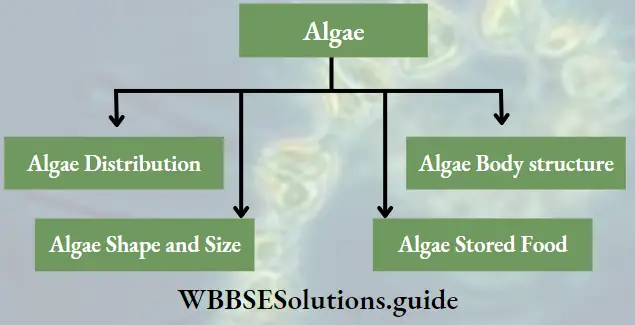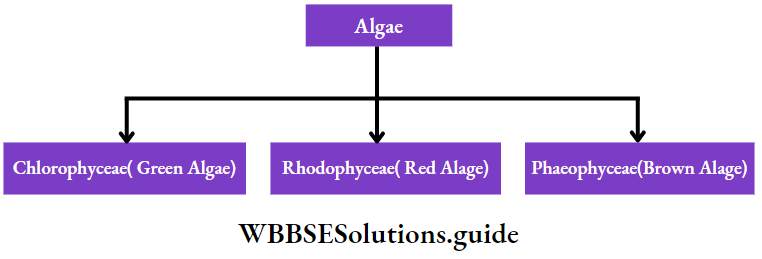Algae
Algae Definition: The chlorophyll-containing, thallophytic, eukaryotic species of plants, that are mainly aquatic are called algae.
Algae The term algae (in Latin, seaweed), was first introduced by Linnaeus in 1753. The algae is an important group of thallophyta (Greek: thallos-a sprout; phyton-a plant), the primitive and simplest group of the plant kingdom.

Algae Distribution:
- The algae are distributed all over the world. Most of the algae are either marine (for example Ulva sp.) or found in freshwater (for example Oedogonium sp.).
- Some species of algae are found on moist soil (for example Vaucheria sp.), on the snow fields of mountains (for example Chlamydomonas nivalis), as epiphyte or endophyte (for example Coleochaete nitellarum).
- Many algae are found in symbiotic association with a fungal component. These symbionts, together are called lichen.
- Some algae are found attached to a substratum while others are free-living on water. Some are found on the bark of the trees.
Read and Learn More: WBCHSE Notes for Class 11 Biology
Algae General features: The general features of algae are discussed below.
Algae Body structure: Algae are chlorophyllous, autotrophic plants. The plant body ranges from unicellular to large multicellular structures. Their body is not differentiated into roots, stems, and leaves.
Hence, their body is thallus-like or thalloid. The multicellular complex thalli lacks vascular tissue and also shows little tissue differentiation.
| Class 11 Biology | Class 11 Chemistry |
| Class 11 Chemistry | Class 11 Physics |
| Class 11 Biology MCQs | Class 11 Physics MCQs |
| Class 11 Biology | Class 11 Physics Notes |
However, some algae may have stem-like stipe and leaf-like lamina. In some cases, the I algae grow root-like structures called holdfast, that help them to remain attached to the substratum.
Algae definition and characteristics notes
Algae Shape and Size: There is a large amount of variation in the shape and size of the algae. They may be microscopic (1.5-3.00 pm) to macroscopic (about 60 m). An example of microscopic algae is Chlamydomonas sp.
While an example of macroscopic algae is Macrocystis sp. Some of them are spherical-shaped (for example Volvox sp.), while some are ribbon-shaped (for example Spirogyra sp.).

Algae Cell wall and mucilage covering: A mucilaginous covering may be present around the cellulose-containing cell wall. This mucilage layer protects the cell from dehydration in dry environmental conditions.
Algae Plastids and pigments: Plastids present in algae have different shapes and sizes. Thylakoids present in the chloroplasts form grana. The main photosynthetic pigment of algae is chlorophyll.
Algae Structure
Besides this, pigments like chlorophyll b, c, carotene, xanthophylls, etc., are also present. Some species of algae may contain different pigments like fucoxanthin (brown), phycoerythrin (red), phycocyanin (blue), etc., which give them distinct colouration.
Algae Nutrition: Due to the abundance of chlorophyll, they are generally autotrophic. Parasitic algae, such as Cephaleuros sp., derive nutrition from their host.
Benefits of algae for skin
Algae Stored food: Different types of carbohydrates, such as starch, mannitol, laminarin Floridian starch, etc., are found in algal cells as stored food.
Algae Locomotion: Some of the algae (like Chlorella, Euglena, etc.), have flagella and/or cilia and hence are motile. Many species produce motile gametes even though the adult plants are non-motile.

Algae Reproduction: Reproduction is of three types— vegetative, asexual and sexual.
- Vegetative reproduction: Most algae show this method of reproduction. It occurs by cell division (Gloeocapsa sp.), fragmentation (Spirogyra sp.), budding (Protosiphon sp.), etc.
- Asexual reproduction: Generally, reproduction takes place by different kinds of diploid or haploid spores like motile zoospores (Ulothrix sp.), non-motile aplanospores (Chlorella sp.), hypnospores (Chlamydomonas sp.) akinetes (Oedogonium sp.), tetraspores (Polysiphonia), etc. Asexual The sex organs are generally unicellular, when multicellular, all cells are fertile, i.e., able to develop I spores. In most cases, this reproductive structure is not enclosed by any protective coverings.

3. Sexual reproduction: Under favourable conditions, sexual reproduction takes place by the production of gametes. Depending on the gametes’ size and motility, sexual reproduction is either isogamous,i.e., both male and female gametes are similar in structure and motility (Spirogyra sp.), anisogamous, i.e., female gametes are larger than male gametes and both are motile (Chlamydomonas sp.) and oogamous, i.e., male gametes are small and motile while female gametes are large and non-motile (Chara sp.).
The gametes are produced inside gametangium. The male gametangium is called antheridium and the female gametangium is called oogonium. The zygote undergoes further development starting either by mitosis or by meiosis. However, this development continues through mitotic cell division. Embryo formation is absent.
Algae Life cycle: The sexually reproducing members of algae show mainly three patterns of life cycles—haplontic life cycle, diplontic life cycle and haplo-diplobiontic life cycle. These types of life cycles are discussed in detail later in this chapter.
Algae as a renewable energy source
Alternation of generations: The members show distinct alternation of gametophytic and sporophytic generations. The gametophytic phase (n) is longer while the sporophytic phase (2n) is shorter. The sporophytic phase is dependent on the gametophytic phase.
Some other features of algae
Algae do not have vascular tissue as they live in water and do not require any specialised tissue for conducting water. Moreover, all cells have chlorophyll and hence can synthesise their own food. Thus they do not need any specific tissue system for translocation of food.
Gametophyte and Sporophyte
The life cycles of all sexually reproducing plants follow a pattern of alternation between the gametophytic phase and sporophytic phase.
Gametophyte is the haploid phase of the life cycle, independent or dependent on the sporophytic phase. In most of the algae and bryophytes, this is the dominant phase.
In some algae and all the higher plants such as pteridophytes, gymnosperms and angiosperms, it is represented only by the gametes. The gametes unite to give rise to the sporophyte.
Sporophyte is the diploid phase of the life cycle. In most algae, it is represented by the zygote. In bryophytes, the sporophytic phase is dependent on the gametophytic phase. In pteridophytes, gymnosperms and angiosperms it is the dominant phase of the life cycle.
Some common examples of algae are— Chlamydomonas sp., Volvox sp., Oedogonium sp., Ulothrix sp., Chara sp., Ectocarpus sp., etc.
Commercial importance of algae: Since ancient times, human beings have used algae for various purposes.
Source of food: The algal species are popular food to mankind due to their high nutritive value and higher yield per unit area than the conventional crops. Some algae are commonly used as food. Some of them are Chlorella sp., Chondrus sp., Ulva sp., etc. Chlorella is also used as a source of minerals, vitamins, lipids and proteins.
Source of fodder: Many algae, like Fucus sp Laminaria sp., Sargassum sp., Rhodymenia sp., etc., are commonly used as fodder in different countries. The fat content of milk increases with the addition of seaweed in fodder. The iodine and carotene content in egg yolk as well as the egg-laying capacity of the poultry birds increases by feeding processed seaweeds as food.
Industrial use: Algae has been used to develop many products of commercial and pharmaceutical importance. These are agar-agar, carrageenan, diatomite, alginate, medicine, etc.
- Agar-agar: Agar-agar is commercially obtained from Gelidium nudifrons, G. pusillum, G. robustrum, Gracilaria verrucosa and also from different species of Gracilaria. It is a jelly-like, synthesised, non-nitrogenous, complex polysaccharide in nature. Agar-agar is used in food (as emulsifiers, gelling and thickening agents), pharmaceutical (as laxative), cosmetic industry and scientific laboratories (in culture medium).
- Carrageenan: It is obtained from the cell wall of Gigartina stellata, Chondrus crispus and Eucheuma. Carrageenan is a hydrocolloid (algal colloid) almost similar to agar-agar. The hydrocolloid consists of alpha-carrageenan and beta-carrageenan. Carrageenan acts as a blood coagulant. It is also used to stabilise emulsions. It is used as a component of deodorants, cosmetics, toothpaste, paints, etc. It is also used for maintaining transparency in alcohol.
- Alginates: Alginates are salts of alginic acid. It is extracted from the cell wall of some brown algae like Ascophyllum sp., Fucus sp., Macrocystis sp., Laminaria sp., etc. It is used as a thickening agent in the food industry, specifically in the preparation of sauce, soup, cream, etc. It is also used as an emulsifier in polish, and emulsion paints, etc., and a gelling agent in confectionaries, powders, etc. It is also used in the production of artificial fibres, plastics, rubbers, etc.
- Diatomite: After the death of diatom cells, the silicified cell walls accumulate at the bottom of water bodies. These deposits are called diatomaceous earth or diatomite. It is very suitable for use in industries as a bacteria filter, insulator, absorbent, etc.
As fertiliser in agricultural fields: Members of Cyanophyceae like Nostoc sp., Anabaena sp., etc., can fix atmospheric nitrogen, and form nitrogenous compounds. These are further absorbed by plants for their metabolic activities and increase yield.
Algae General Character
Minerals like copper, cobalt chromium, boron, iron, zinc, vanadium and manganese are present in high amounts in seaweeds. Hence, these are used as stock feed as well as natural fertiliser. Algae like Tolypothrix spv Lyngbya sp. can prevent soil erosion.
Disposal of sewage: Industrial effluents and domestic drain water are called sewage. It is rich in sulphur, nitrogen, phosphorus and potassium. The anaerobic breakdown of sewage gives rise to a bad odour.
So aerobic breakdown is preferred, which is carried out by some bacteria. The oxygen required for this process is provided by algae. Unicellular algae like Chlorella sp. are used in this process.
Medicine preparation:
- Since marine algae such as Laminaria sp., Fucus sp., etc., contain high amounts of iodine, hence, can be used to prepare medicines to treat goitre.
- Agar-agar obtained from Gelidium sp., and Gracilaria sp., is used as a laxative, or base of various ointments.
- Certain antibiotics like chlorellin, are prepared from Chlorella sp. and other algal species.
Experimental use: Algae are used as experimental tools for different kinds of research works. For example, Chlorella has been used to study the path of carbon in photosynthesis and Acetabularia is used in genetic research. Halicystis sp. is used to study membrane permeability, etc.
Algae farming for biofuel
Use in the ecosystem:
- At least half of the total carbon dioxide fixation on earth is carried out by algae.
- Aquatic algae are mainly responsible for the increased oxygen level in the aquatic ecosystems.
- Chlorella sp and Spirulina sp. are unicellular algae, rich in protein and used even by astronauts as sources of oxygen and food.
Algae Bloom
Generally during monsoon, the growth of algae on water bodies, such as ponds, lakes, etc., increases. Due to this, the concentration of dissolved oxygen decreases, causing the death of the organisms. This excess growth of algae is called an algal bloom. Microcystis sp., Oscillatoria sp., etc., are responsible for algal bloom.
Classification of algae:
According to the pigments present, algae can be classified under the following families—

These groups have been discussed in detail, under separate heads.
